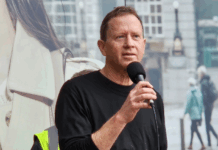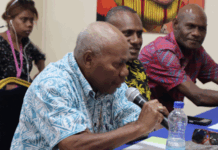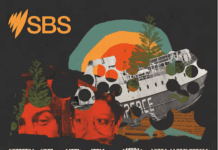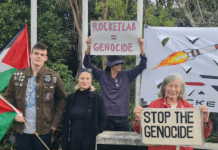
By Kendall Hutt in Auckland
Black-and-white photographs are aiming to start a conversation and dispel myths around former refugees and asylum seekers in New Zealand.
Transplanted: Refugee portraits of New Zealand showcases two-metre tall, black-and white-close-up portraits of former refugees by award-winning photographer Alistair Guthrie.
The portraits are currently on display in a ten-day exhibition at the New Zealand Portrait Gallery in Wellington.
“Refugees lives have been pulled up from the roots and transplanted on new soil,” explains curator and journalist Tracey Barnett.
“I created Transplanted because I wanted to show the regeneration of lives, that these people can become our future – carpenters and teachers and insurance brokers and our art gallery directors just like anyone else.
“In New Zealand about roughly 45 percent of our quota intake are children. They grow up to be Kiwis in every sense of the word.
“You may not even recognise that they began life as a refugee because they speak with a Kiwi accent, eat pineapple lumps, and cheer for the All Blacks on a Saturday night just as loudly as anyone else,” Barnett said.
Refugee ‘talking space’
Transplanted opened with a talk by former Prime Minister Sir Geoffrey Palmer on Friday and continues until Sunday, November 5 with insights from former refugees and international diplomats.

The gallery exhibition is also a “refugee talking space”, intended to turn the tide on negative perceptions of refugees, both globally and closer to home.
“It has been incredibly saddening and worrying to see the label of refugees become so disrespected.
“These people have overcome tremendous odds and tremendous difficulties to get to safety, something any of us would aspire to,” Barnett told Asia Pacific Report.
Barnett, who serves on the executive board of the Refugee Council of New Zealand, said the media was partly to blame.
“Unfortunately the media shows these people always in the worst moments of their lives, but the reality is that it’s just one short chapter of a much bigger life.”
A highlight has been the ‘Human Library’ sessions, Barnett said, where former refugees speak one-on-one with the public.
Lives in limbo
“It’s been incredibly moving, enjoyable and informative I think for everyone who’s participated and it’s a real highlight.”

But while some refugees lives have been “transplanted on new soil” in New Zealand, the lives of asylum seekers in one of Australia’s offshore detention centres remain in limbo.
“These refugees have every reason to be afraid and every reason to be worried that they will not be protected and they will not be safe,” Barnett said.
The words of Wage Peace NZ’s founder come as a 2013 offer by New Zealand to take in 150 refugees a year from Australia’s detention centres remains “nixed” by Australia.
This means asylum seekers on Manus Island, around 600 of whom are refusing to leave the now closed centre, are being forced to relocate to several sites in nearby Lorengau – including the Manus Refugee Transit Centre – or “trade one hell for another” for the “other prison island” of Nauru where human rights abuses are rife, Barnett said.
Many of the single men who remain on Manus fear for their lives, with reports locals have allegedly already looted the centre.
Barnett said “there have been worrying and frightening outbreaks of violence” in the past.
Manus supplies cut
These outbreaks of violence include a shooting on April 14, 2017 in which bullets were directly fired into the refugee centre by security forces.
All power, water and food supplies have stopped at the refugee processing centre.
A notice posted by Papua New Guinea’s Immigration and Citizenship Service Authority stated all staff had left and the site would be returned to the Defence Force today.
“This is the last communication you will receive at this location,” the notice stated.

The closure of Manus Island comes after PNG’s Supreme Court ruled last year the centre was illegal and unconstitutional.
Barnett said New Zealand’s new Labour-led government should also be applying “huge pressure” and push to renegotiate its 2013 deal with Australia.
“This makes a perfect opportunity for Prime Minister Jacinda Ardern to stand back and say ‘I’m a new government, this is a new possibility, let’s talk about doing this as a one-off instead and helping you evacuate the camps, but you must agree to not reopen them’,” Barnett said.
Examine NZ offer
Ardern has said she would renew the offer after examining the proposal Australia continues to reject.
“I want to look at the detail of the offer that was made and the obligations that we’ve set out that we would take on,” she said.
“Of course that would be within our refugee quota, and within existing intent that we’ve shared with the UN around taking UN mandated refugees.”
Green MP Golriz Ghahraman, herself a former refugee from Iran, has recently labelled New Zealand’s alleged silence over the past four years as ‘complicity’.

Ghahraman will be speaking this evening at the exhibition on the ‘I am not a label: Young refugee voices’ panel.
Manus Island’s closure also provides an opportunity to provide “fresh eyes” on New Zealand’s own refugee policies, Barnett said.
“New Zealand has never pulled its weight when it comes to our quota.
‘We can do more’
“Unfortunately we rank 95th worst in the world per capita for the total number of refugees and asylum seekers we host.
“If you measure it by our relative wealth, our GDP, it’s even worse and we rank 121st worst in the world.
“That isn’t good enough and we can do more,” Barnett said.
Although it was “wonderful” New Zealand’s quota was going up to 1500, Barnett stated it would be a while before refugees felt its impact.
“The quota is only reviewed every three years and we’ll be changing our quota in 2018. It will be several years again before we hit that 1500 mark.
“I’m hoping that the government will consider changing that number earlier and faster to make a bigger impact.
“We can do more and we should.”











































